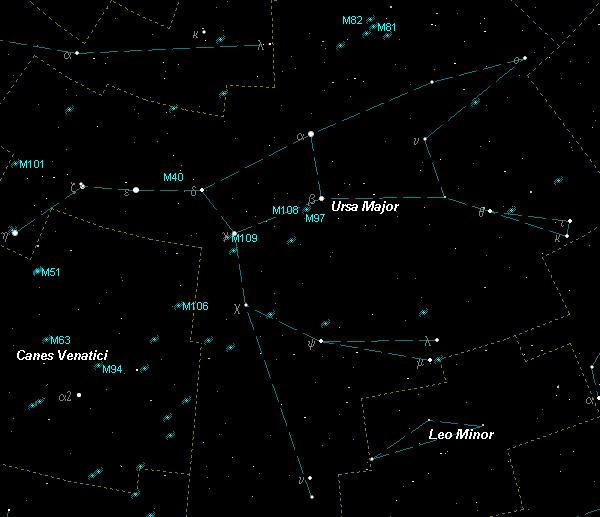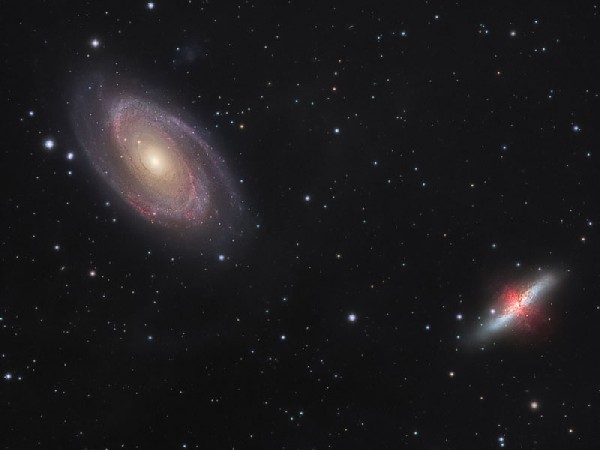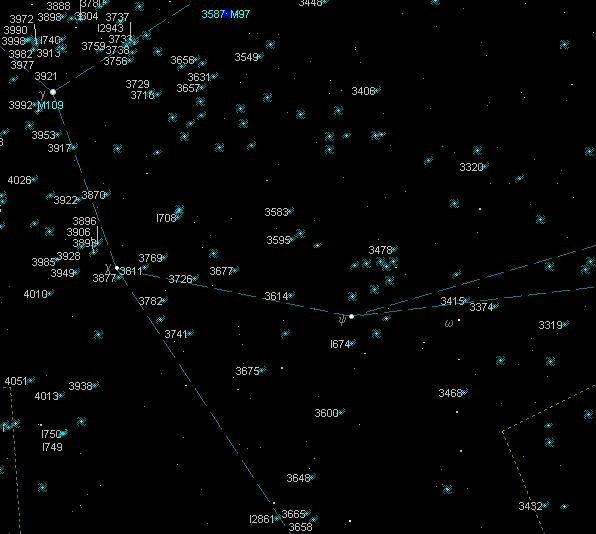The Big Bear
If you were to ask anyone to name a constellation in the sky, ninety-nine percent of the time that person would say the Big Dipper or the Big Bear. And why not? Referred by astronomers as Ursa Major or Ursae Majoris, the Big Dipper is the first star pattern we studied in school and is by far the most recognized celestial group. It also helps that Ursa Major is a circumpolar constellation and can be seen somewhere about the northern horizon throughout the year. As you move down in latitude, your chances of seeing it all year round diminish. Distances to these main seven stars of the asterism range from 78 to 123 light-years (ly).
Ursa Major is a handy stepping stone when trying to locate the North Star – Polaris in the Little Dipper. You simply take the two pointer stars named Merak at magnitude 2.4 and second magnitude Dubhe located opposite the tail and draw an imaginary line through these two stars till you reach your target. Ursa Major is ranked third and takes up 1,280 square degrees of celestial real estate.

Last month I wrote about the treasure of galaxies from Virgo, Leo and Coma Berenices. Ursa Major is the end of this fog of galaxies. An amazing 558 NGC objects live within these borders.
The Big Bear is also home to no less than seven Messier objects (M81, M82, M97, M101, M108 and M109. However, M40 is an erroneous entry as it consists of only two stars. Modern astronomers have identified eight stars within the Dipper’s boundaries with known planets orbiting them.
So why does the Bear sport such a long tail? Legend has it the Hera, the wife of mighty Zeus, turned Callisto a suspected mistress of Zeus into the bear. Just as Callisto was to be killed by hunters; Zeus grabbed her by the tail and swung her up to the safety of the sky, thus stretching the tail. The sky is filled with many mythological stories such as this.
Locate the middle star in the handle, where it bends. What you see with the unaided eye if the sky is transparent, are two stars. Bright Mizar and fainter Alcor – dubbed the horse and rider respectively. Splitting these without a telescope or binoculars is a good indication of how dark and transparent the sky is. Mizar is actually a double in itself with Mizar ‘A’ being magnitude 2.27 and Mizar ‘B’ at 3.95.
The two best Messiers in Ursa Major and a favourite at star parties are M81 and M82 (illustrated above). A stellar view in wide-angle telescopes, these distant but different galaxies appear in the same field of view. M81 is wide and is an estimated twelve million light-years away and is also known as Bode’s Galaxy. At magnitude 7.89, it is brighter than M82’s magnitude 9.2.
M82 is commonly referred to as the Cigar Galaxy and is a starburst galaxy measuring five times the length of ours or five hundred thousand light-years long. It appears that stars are being born some 10 times faster in M82 than in our Milky Way Galaxy. This is a very interesting object.

Moving down the bowl of the Dipper to Merak we find M108 about 1.3 arc minutes west of the star. M108 is a 10th magnitude edge-on galaxy when sporting a bit of detail in its arms. Measuring 8 X 1 arc minutes, M108 is estimated to lie some forty-five million light-years from us. Surprisingly, this galaxy does not have the usual nucleus that bulges from its galactic center. Instead, the hub of the galaxy remains the same thickness as the rest of M108.
Next, we come to the elusive Owl nebula, aka M97 and this one is a bit of a challenge to pick up in small scopes. At magnitude 9.9, it should be easy to find this planetary nebula but its magnitude value can be deceiving. The light is dispersed flat over 3.4 by 3.3 arc minute size and therefore diluted. Astronomers believe the initial star died 6,000 years ago. Over time, an escaping shell of star-stuff formed the now bubble formation. The Owl lays 2,600 ly from us.

A truly delicious dish of challenging galaxies for astrophotographers would be NGC 2857 and company. At close to 15th magnitude, this spiral galaxy appears face-on thus shows exquisite arm structure as if it were a drawing. It is small and far – only measuring 2.4 X 2.2 arc minutes and resides 220 million light-years away. A mere six arc minutes away is NGC 2856 and just past that is NGC 2854 both of which are in the magnitude 13.5 range.
M101 is another large, well detailed face-on galaxy. At 22 arc minutes, it takes up two-thirds the area of the full moon. Being some 26 million light-years – it still has a decent size. M101 if fairly bright at magnitude 7.8. To locate M101, first, locate Alcor/Mizar in the handle. Now follow the chain of four stars, moving in the same direction as the tail but not along it. You should see it now. In the past 100 years, M101 has seen no less than three supernovas. The events were seen in 1909, 1951 and lastly in 1970.
| Object | Type | Magnitude | R.A. | Dec. |
|---|---|---|---|---|
| M81 | Galaxy | 6.9 | 9h 55m | +69° 4' |
| M82 | Galaxy | 8.4 | 9h 55m | +69° 41' |
| M97 | Galaxy | 11.2 | 11h 14m | +55° 1' |
| M101 | Galaxy | 7.7 | 14h 03m | +54° 21' |
| M108 | Galaxy | 10.1 | 11h 11m | +55° 40' |
| M109 | Galaxy | 9.8 | 11h 57m | +53° 23' |
| NGC 2857 | Galaxy Group | 14.9 | 9h 24m | +49° 21' |
Saturn is still riding high in the sky under Leo. As we inch closer to September’s plane crossing, you can still see a bit of ring detail but that is harder to see as the weeks go on. We can track the moons of the planet as they swing around.
And speaking of plane crossing, Jupiter’s moons are putting on a great show for the time being. Close to every six years, Jupiter’s plane points to us so its moons line up with Earth. On a few occasions, one moon will pass in front or occult the other. I witnessed a few of these rare alignments and they are spectacular and occur quickly. Here is a list of events. At the beginning of June, Jupiter is up in the ESE around 2:30 a.m. local time and just after midnight this time next month. Also, look for Neptune scooping northwest of Jupiter.
The full Strawberry Moon will occur on June 7th so plan your observing run accordingly. As a side note, now that the Hubble Space Telescope has a new lease on life with state of the art parts, the door to the wonderful world of astronomy will only open wider. Stay tuned for more dazzling images from above.
The summer solstice will occur on June 21st at 1:45 a.m. eastern time. Solstice means ‘Sun stands still’. This marks the highest point the Sun appears on the ecliptic in summer as well as the lowest point in winter as seen from the Northern Hemisphere. The Southern Hemisphere will ring in their winter solstice. From this moment till December, our days get a bit shorter and the nights get a tad longer.
Till next month, clear skies everyone.
